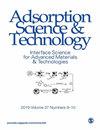Effective and Simple NaOH-Modification Method to Remove Methyl Violet Dye via Ipomoea aquatica Roots
IF 3.2
4区 工程技术
Q2 CHEMISTRY, APPLIED
引用次数: 25
Abstract
In this study, a simple chemical modification was applied to a sustainable and abundantly available resource, kangkong root (KR), to remove methyl violet 2B (MV) dye. The chemically modified adsorbent (NaOH-KR) was obtained using NaOH solution treatment. Batch adsorption experiments were carried out to investigate the effects of pH, ionic strength, contact time, adsorbent dosage, and initial dye concentration. A regeneration experiment was also carried out to assess the potential of reusability. The adsorption process was modelled using various kinetics and isotherm models, whereby the best-fitting models were evaluated by using the coefficient of determination ( R 2 ) and error functions. The Sips ( R 2 = 0.9714 , χ2 =0.16) and pseudo-second-order ( R 2 = 0.9996 , χ 2 = 0.007 ) models were identified to best represent the adsorption process. The Sips model predicted a maximum adsorption capacity at 551.5 mg g-1 for NaOH-KR, which is 55% improvement in performance when compared to nonmodified KR. Lastly, the regeneration experiment showed that NaOH-KR was able to maintain reasonable dye removal even after five consecutive cycles of regenerating and reusing.有效、简便的氢氧化钠改性法去除水草根甲基紫染料
本研究采用简单的化学改性方法对资源丰富、可持续发展的康孔根(KR)进行甲基紫2B (MV)染料的脱除。采用氢氧化钠溶液处理制得化学改性吸附剂NaOH- kr。通过批量吸附实验考察了pH、离子强度、接触时间、吸附剂用量、初始染料浓度等因素对吸附效果的影响。还进行了再生实验,以评估可重复使用的潜力。采用各种动力学和等温线模型对吸附过程进行了建模,并利用决定系数(r2)和误差函数对最佳拟合模型进行了评价。Sips模型(r2 = 0.9714, χ2 =0.16)和伪二阶模型(r2 = 0.9996, χ2 = 0.007)最能反映吸附过程。Sips模型预测NaOH-KR的最大吸附量为551.5 mg g-1,与未改性的KR相比,性能提高了55%。最后,再生实验表明,即使经过连续5次再生和再利用,NaOH-KR仍能保持合理的染料去除率。
本文章由计算机程序翻译,如有差异,请以英文原文为准。
求助全文
约1分钟内获得全文
求助全文
来源期刊

Adsorption Science & Technology
工程技术-工程:化工
CiteScore
5.00
自引率
10.30%
发文量
181
审稿时长
4.5 months
期刊介绍:
Adsorption Science & Technology is a peer-reviewed, open access journal devoted to studies of adsorption and desorption phenomena, which publishes original research papers and critical review articles, with occasional special issues relating to particular topics and symposia.
 求助内容:
求助内容: 应助结果提醒方式:
应助结果提醒方式:


